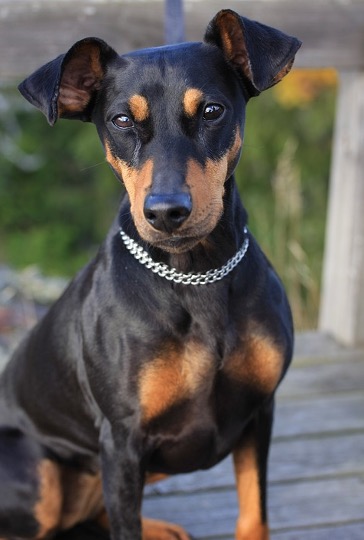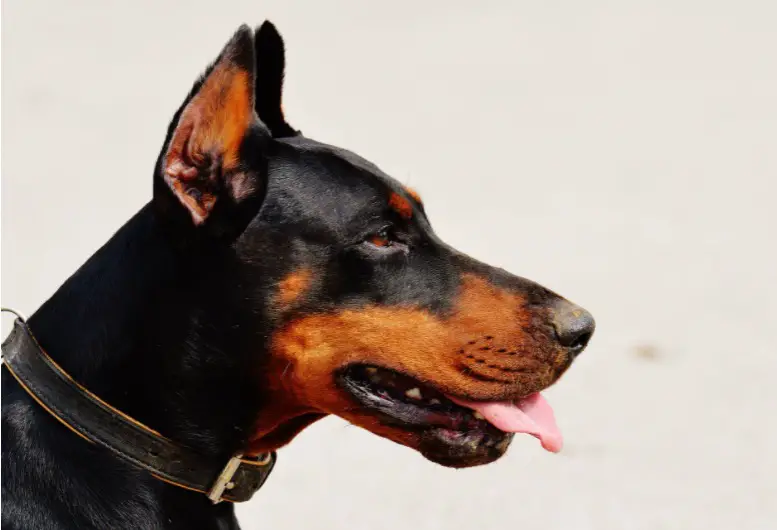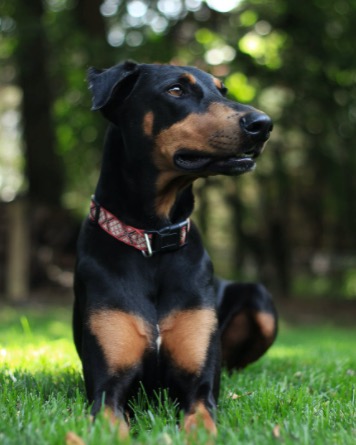Table of Contents
German Pinscher: All You Need To Know
A German pinscher is the domestic dog breed that belongs to the kingdom of Animalia, phylum Chordata, and class Mammalia. Its genus is Canis, and its species is C. lupus. Its length is up to 43 to 51 cm, and it weighs about 11 to 20 kg. It lives in a domesticated habitat, with a lifespan of up to 12 to 14 years.

What is German Pinscher?
The German Pinscher is a domestic dog breed that is medium in size. The breed’s members are predominantly black, with a long, streamlined physique. They are frequently employed as security dogs and are also popular pets and show dogs. German pinschers resemble the Doberman Pinscher but are smaller or bigger than the tiny pinscher.
In reality, it was most likely the ancestor of the other two. They are robust and sturdy, weighing 25-45 pounds (11-20 kg) at the withers and measuring 17-20 inches (43-51 cm) tall. Their coats are glossy and silky, and they are usually black with tan feet and patterns on their faces. Additional coat colours, such as red, ‘fawn,’ or blue with tan or red patterns, are available.
Additional colour variants, such as pure black and the ‘salt-and-pepper’ type, existed before the World Wars but have since become extinct. Historically, most members of the breed had docked tails and clipped ears for aesthetic reasons as well as health concerns that were mostly unfounded. This technique is still practised today where it is permitted, primarily for cosmetic reasons.

German pinschers were created in Germany in the late 1700s as a working and hunting dog for catching vermin. The German Pinscher, which spawned a slew of different dog varieties, was most likely derived from the now-extinct Rat Pinscher. It was classified as a breed in 1895, but, like many other breeds, it fell out of favour during the World Wars, nearly going extinct.
After WWII, Werner Jung, a West German, was successful in reviving the breed, and the breed arrived in the United States in the 1970s. The American Kennel Club officially approved the breed in 2003. The breed is now ranked 134th in popularity among AKC-recognized breeds.

German Pinscher as a Pet
German Pinschers are great security dogs as well as loving family companions. They are attentive and lively, with a reputation for being good-natured, albeit not always independent. They are adaptable and intelligent, but their large size and high energy levels make them best suited to a home with a yard in which they can run.
German Pinschers are very social dogs who want to be a part of everything their family does. They are not generally well-suited to homes with other tiny pets such as guinea pigs, because of their history of being used as dogs to hunt mice. They may be domineering and arrogant, making them a poor choice for novice or timid dog owners.
Because of their protective nature and proclivity to hunt smaller animals, they require rigorous, early, and regular training and socialisation to achieve their full potential as pets. Females give birth to litters of 6-8 pups on average. Despite certain health concerns caused by a small gene pool, German Pinschers live a pretty long time. Mostly will survive for 12 to 14 years.
Fun Facts About German Pinscher!
Despite the fact that German Pinschers, along with their bigger Doberman and smaller Minature counterparts, did not arrive in the United States until recently, they are now a well-known breed. Due to their high levels of devotion and intelligence, they are increasingly common pets, show dogs, and even therapy and service dogs.

German Pinscher: a Softer Side
Although pinschers are frequently associated with growling guard dogs, they make wonderful family pets and friends. They’ve also had success in other arenas, including conformation exhibitions and agility and speed events. Therapy dogs are also utilised with pinschers. Because of their intelligence and trainability, they are ideal for this task. Therapy dogs can provide emotional support to individuals recovering from sickness or dealing with mental health issues.
Strength and Grace
German Pinschers are recognised for their beauty and grace, despite their efficiency as guard dogs and strong loyalty to their masters. They have a slender physique and long, skinny legs. They frequently have pointed ears as a result of legal cropping methods, which adds to their powerful and pointed characteristics.
German Pinscher: Son of a Schnauzer
The Standard Schnauzer is a contemporary dog breed that originated in Germany in the 1400s. It was once known as the “Wire-Haired Pinscher,” and it was frequently born in the same litter as the German Pinscher. Breeders would eventually separate these variations, resulting in the creation of highly different breeds.
Despite their dissimilar looks, their mutual habits reveal their common ancestors. Both species have an inherent desire to hunt tiny vermin and, as pets, become quite thrilled about the idea of chasing small creatures about the forest in vain.
German Pinscher Citations
- A rare form of persistent right aorta arch in linkage disequilibrium with the DiGeorge critical region on CFA26 in German Pinschers. J Hered . Sep-Oct 2011;102 Suppl 1:S68-73.
- Postvaccination encephalomyelitis in German pinschers. Vet Rec . 2021 Mar;188(6):231-232.
- Prevalence and formation of primary cataracts and persistent hyperplastic tunica vasculosa lentis in the German Pinscher population in Germany. Vet Ophthalmol . 2015 Mar;18(2):135-40.







